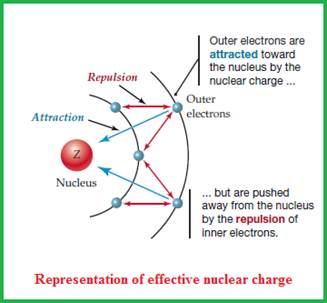
Concept explainers
(a)
Interpretation:
Based on the effective nuclear charge, the strongest and weakest reducing agent has to be identified from the given ions.
Concept Introduction:
Effective nuclear charge:
The overall nuclear charge felt by an electron is known as effective nuclear charge. Because, the attraction between nucleus and the outer shell electron is reduced by the inner shell electrons. This effect is described by saying outer electrons are shielded from the nucleus by the inner electrons.
The value of
Representation of effective nuclear charge:

Figure 1
(b)
Interpretation:
Based on the effective nuclear charge, the strongest and weakest reducing agent has to be identified from the given oxoanions.
Concept Introduction:
Effective nuclear charge:
The overall nuclear charge felt by an electron is known as effective nuclear charge. Because, the attraction between nucleus and the outer shell electron is reduced by the inner shell electrons. This effect is described by saying outer electrons are shielded from the nucleus by the inner electrons.
The value of
Representation of effective nuclear charge:

Figure 1
Want to see the full answer?
Check out a sample textbook solution
Chapter 20 Solutions
General Chemistry: Atoms First
- Answer the following questions by referring to standard electrode potentials at 25C. a Will oxygen, O2, oxidize iron(II) ion in solution under standard conditions? b Will copper metal reduce 1.0 M Ni2(aq) to metallic nickel?arrow_forwardAn aqueous solution of an unknown salt of vanadium is electrolyzed by a current of 2.50 amps for 1.90 hours. The electroplating is carried out with an efficiency of 95.0%, resulting in a deposit of 2.850 g of vanadium. a How many faradays are required to deposit the vanadium? b What is the charge on the vanadium ions (based on your calculations)?arrow_forwardA constant current of 1.25 amp is passed through an electrolytic cell containing a 0.050 M solution of CuSO4 and a copper anode and a platinum cathode until 3.00 g of copper is deposited. a How long does the current flow to obtain this deposit? b What mass of silver would be deposited in a similar cell containing 0.15 M Ag+ if the same amount of current were used?arrow_forward
- A constant current of 1.40 amp is passed through an electrolytic cell containing a 0.100 M solution of AgNO3 and a silver anode and a platinum cathode until 2.48 g of silver is deposited. a How long does the current flow to obtain this deposit? b What mass of chromium would be deposited in a similar cell containing 0.100 M Cr3+ if the same amount of current were used?arrow_forwardCopper(I) ion disproportionates to copper metal and copper(ll) ion. (See Study Question 99.) 2 Cu+(aq) Cu(s) + Cu2 + (aq) (a) What two half-reactions make up the disproportionation reaction? (b) Use values of the standard reduction potentials for the two half-reactions in part (a) to determine whether this disproportionation reaction is product-favored at equilibrium. (c) What is the equilibrium constant for this reaction? If you have a solution that initially contains 0.10 mol of Cu+ in 1.0 L of water, what are the concentrations of Cu+ and Cu2+ at equilibrium?arrow_forwardAn electrode is prepared by dipping a silver strip into a solution saturated with silver thiocyanate, AgSCN, and containing 0.10 M SCN . The cell potential of the voltaic cell constructed by connecting this electrode as the cathode to the standard hydrogen half-cell as the anode is 0.45 V. What is the solubility product of silver thiocyanate?arrow_forward
- An aqueous solution of an unknown salt of gold is electrolyzed by a current of 2.75 amps for 3.39 hours. The electroplating is carried out with an efficiency of 93.0%, resulting in a deposit of 21.221 g of gold. a How many faradays are required to deposit the gold? b What is the charge on the gold ions (based on your calculations)?arrow_forwardUse electrode potentials to answer the following questions, assuming standard conditions. a Do you expect permanganate ion (MnO4 ) to oxidize chloride ion to chlorine gas in acidic solution? b Will dichromate ion (Cr2O72) oxidize chloride ion to chlorine gas in acidic solution?arrow_forwardAn electrode is prepared from liquid mercury in contact with a saturated solution of mercury(I) chloride, Hg2Cl, containing 1.00 M Cl . The cell potential of the voltaic cell constructed by connecting this electrode as the cathode to the standard hydrogen half-cell as the anode is 0.268 V. What is the solubility product of mercury(I) chloride?arrow_forward
 Principles of Modern ChemistryChemistryISBN:9781305079113Author:David W. Oxtoby, H. Pat Gillis, Laurie J. ButlerPublisher:Cengage Learning
Principles of Modern ChemistryChemistryISBN:9781305079113Author:David W. Oxtoby, H. Pat Gillis, Laurie J. ButlerPublisher:Cengage Learning General Chemistry - Standalone book (MindTap Cour...ChemistryISBN:9781305580343Author:Steven D. Gammon, Ebbing, Darrell Ebbing, Steven D., Darrell; Gammon, Darrell Ebbing; Steven D. Gammon, Darrell D.; Gammon, Ebbing; Steven D. Gammon; DarrellPublisher:Cengage Learning
General Chemistry - Standalone book (MindTap Cour...ChemistryISBN:9781305580343Author:Steven D. Gammon, Ebbing, Darrell Ebbing, Steven D., Darrell; Gammon, Darrell Ebbing; Steven D. Gammon, Darrell D.; Gammon, Ebbing; Steven D. Gammon; DarrellPublisher:Cengage Learning Chemistry: The Molecular ScienceChemistryISBN:9781285199047Author:John W. Moore, Conrad L. StanitskiPublisher:Cengage Learning
Chemistry: The Molecular ScienceChemistryISBN:9781285199047Author:John W. Moore, Conrad L. StanitskiPublisher:Cengage Learning Chemistry & Chemical ReactivityChemistryISBN:9781337399074Author:John C. Kotz, Paul M. Treichel, John Townsend, David TreichelPublisher:Cengage Learning
Chemistry & Chemical ReactivityChemistryISBN:9781337399074Author:John C. Kotz, Paul M. Treichel, John Townsend, David TreichelPublisher:Cengage Learning Chemistry & Chemical ReactivityChemistryISBN:9781133949640Author:John C. Kotz, Paul M. Treichel, John Townsend, David TreichelPublisher:Cengage Learning
Chemistry & Chemical ReactivityChemistryISBN:9781133949640Author:John C. Kotz, Paul M. Treichel, John Townsend, David TreichelPublisher:Cengage Learning Chemistry: Principles and PracticeChemistryISBN:9780534420123Author:Daniel L. Reger, Scott R. Goode, David W. Ball, Edward MercerPublisher:Cengage Learning
Chemistry: Principles and PracticeChemistryISBN:9780534420123Author:Daniel L. Reger, Scott R. Goode, David W. Ball, Edward MercerPublisher:Cengage Learning





